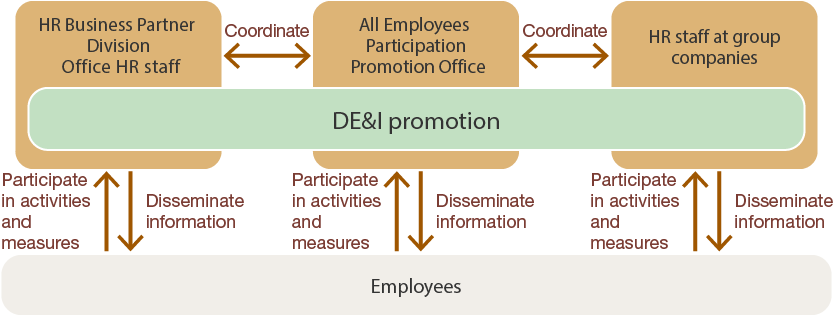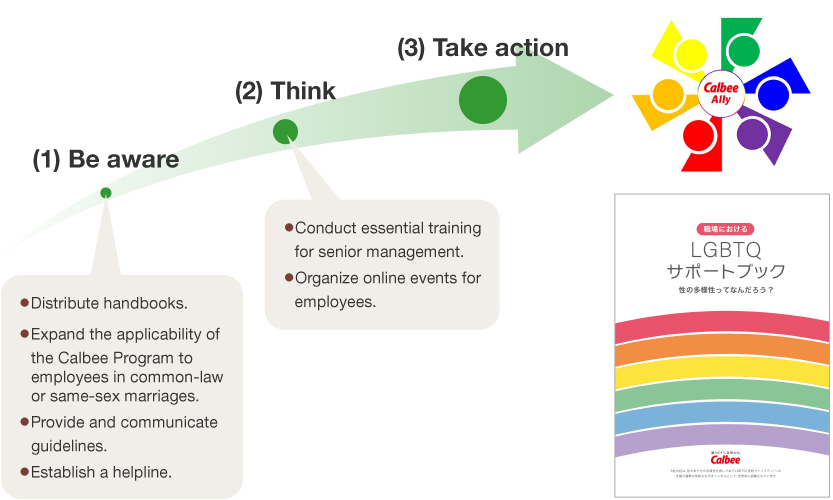Promotion of diversity, equity, and inclusion (DE&I)
The Calbee Group is committed to ensuring that all employees from diverse backgrounds can thrive, regardless of their gender, nationality, age, or disability. We strive to create an environment where everyone takes pride in their work, experiences personal growth, and feels they are making meaningful contributions by leveraging their unique strengths and characteristics. We promote DE&I management that values individuality and drives positive results for both the organization and the company. Women account for nearly half of Calbee’s entire workforce. Based on our belief that the active participation of female employees accelerates the Calbee Group’s growth, we aim to increase the number of women in management roles to at least 30% by FY2030. Upholding the principle that “everyone is aware of their unconscious biases and everyone has equitable opportunities to thrive,” we will continue to strengthen our efforts to create a better working environment for every employee.
Promotion framework
The department specializing in promoting DE&I was established and began full-scale operations in 2010. Currently, the All Employees Participation Promotion Office of the Head Office is working on this together with the human resources promotion staff at each business entity (including Group companies). In addition to implementing company-wide activity measures, we are also taking actions to solve problems and increase the level of penetration at each business entity.
Organization framework

Promotion of empowerment of female employees
Women account for nearly half of Calbee’s entire workforce. Based on our belief that the active participation of women accelerates the Calbee Group’s growth, we aim to increase the number of female employees in management roles to at least 30% by FY2030, so that female representation in the decision-making process would be proportional to the percentage of women in our workforce.
Under the leadership of top management, we are systematically and continuously promoting women’s advancement in the workplace, organizing a range of training programs and workshops, and striving to create a pleasant and rewarding workplace environment.
Percentage of women in management roles

Initiatives to support the active participation of women
| Initiatives | Program description |
|---|---|
| Food manufacturers’ joint training program for female employees | A training program that allows participants to learn from other food manufacturers as role models to help them take a step forward toward their future career goals. |
| Female leader development program | A selective training program aimed at future leader candidates to help them keep a good work-life balance, develop a career mindset, and improve problem-solving skills. |
| Inter-company networking program for female managers | Training for female employees in management roles to improve their skills to solve organizational issues by involving those around them, and at the same time expand their network outside the company to use as a springboard for playing even greater roles in the future. |
| Seminar for returning to work after childcare leave | Participants develop a mindset and the know-how to balance work commitments and childcare responsibilities through conversations with superiors and from the experiences of seniors to help them return to work with confidence after childcare leave. |
| Communications support from the pregnancy to preschool phase | As part of supporting female employees from pregnancy to the preschool phase of their child’s life, they are provided with a handbook that explains when and how to communicate with supervisors and junior staff, allowing them to take time off smoothly and transition back to work. |

Female leader development program

A booklet that supports female employees’ communication from pregnancy through their child’s early years
Promoting the active participation of diverse human resources
Turning differences in values into organizational strength
We believe that recognizing differences in each other’s values and experiences is essential for diverse talents to utilize their strengths and enhance organizational capabilities. We provide training programs that educate employees about unconscious bias and psychological safety, encouraging them to foster mutual understanding and appreciate inclusion through daily dialogues at work.
Encouraging employment of people with disabilities
In 2007, Calbee Group established a special subsidiary, Calbee Eatalk Co., Ltd., in Shiga Prefecture, aiming to create a company where all employees can play an active role regardless of disability status. Calbee Eatalk employs many individuals with severe disabilities, with the packaging of souvenir products as its primary business. Eatalk opened its Utsunomiya Office in 2018 and Hiroshima Office in 2025, aiming to expand the scale of the business. Calbee and Calbee Eatalk had a combined employment rate of 2.80% for people with disabilities in the fiscal year ended March 2025.
As we leverage the expertise of this special subsidiary, all companies in the Group will be working together to promote the hiring of employees with disabilities while broadening the scope in which they can actively contribute.
LGBTQ-related initiatives
The Calbee Group respects human rights and prohibits discrimination or harassment based on sexual orientation or gender identity, as spelled out in the Calbee Group Human Rights Policy and the Calbee Group Code of Conduct. Accordingly, we are committed to developing a safe working environment for LGBTQ people and providing opportunities for non-LGBTQ people to change their awareness by receiving training or viewing videos. Our goal is to create a workplace and corporate culture where all employees, both LGBTQ and non-LGBTQ people alike, can put their enthusiasm and energy into their work while being themselves.

Supporting the active participation of diverse human resources
| Main programs | Details |
|---|---|
| Postpartum childcare leave | Employees can take up to 4 weeks off during the first 8 weeks after childbirth. |
| Childcare leave | Childcare leave can be used up to the day before the child’s second birthday. |
| Shortened working hours for childcare | The specified working hours per day are five hours or more, and working hours can be reduced in 30-minute increments (until child finishes third grade). |
| Parenting support leave | Employees can take 10 consecutive or separate days off (with pay) anytime from six weeks prior to the partner’s expected due date (or 14 weeks for multiple pregnancies) up to the day before the child’s second birthday. |
| Childcare leave for returning employees | Employees who have returned to work after giving birth can take five consecutive or separate days off (with pay) during the first year after returning to work. |
| Child nursing leave | Employees can take up to 10 days off per year in daily, half-day, or hourly increments (until the child finishes the third grade). |
| Nursing care leave | Can be used consecutively within one year for one person requiring nursing care for a period approved by the company. |
| Shortened working hours for nursing care | Specified working hours per day are six hours or more, and working hours can be reduced in 30-minute increments (up to two times in three years per person requiring nursing care). |
| Family nursing care leave | Up to 10 days per year, able to be used in half-day increments. |
| Fertility treatment cost subsidy program | Money given as part of the costs of fertility treatment for married couples. |
| One-time maternity and childcare payment | Given as part of maternity expenses, together with an additional payment |
| Thank-you-for-returning-to-work-early payment (Ex gratia payment for early return to work) | Given to employees who return to work within one year of childbirth to thank them for returning early and to show that the company looks forward to their active contribution. |
| Congratulatory payment for elementary school enrollment | Money given to congratulate employees on their child’s enrollment in elementary school |
| Financial aid for school costs (offered when parents go back to full-time work) | Financial aid to cover the educational costs of children when parents go back to full-time work |
| Cafeteria Plan subsidies (for childcare, family nursing care, and personal and professional development) | Subsidies aimed at encouraging employees to make efforts to develop their self-reliance and autonomy |
An electronic handbook that summarizes Calbee’s support scheme for balancing work and life events that can happen to anyone, as well as information and insights related to the scheme.


